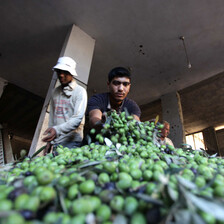The Electronic Intifada Gaza City 4 November 2014

Children from the al-Serhy family sit atop bags of harvested fruit.
Yousef al-Serhy and his family were cheerful on Friday evening as they waited in a van in front of the large olive oil extraction facility on Salah al-Din road, south of Gaza City.
The children sat on top of the large sacks of olives that would soon be pressed.
“We’re waiting our turn, we have two tons of olives grown on our farm,” al-Serhy, a father of four who is in his thirties, told The Electronic Intifada.
“Growing olives has been our main occupation for decades, as my grandfather owned a piece of land in Johr al-Deek,” an area east of Gaza City, he explained.
Al-Serhy said that the family’s groves in that area were badly damaged in Israel’s summer invasion of Gaza, a repeat of what happened during Israel’s attack in 2008-09.
But fortunately, the family still owns a piece of land in the Sheikh Ijleen area west of Gaza City. “Only God’s care protected the olive trees on that land,” al-Serhy said.
“During the war we had difficulty accessing the olive trees. It was only during the times of ceasefire that we managed to get over there and irrigate them,” he added, referring to several brief “humanitarian truces” that gave Gaza residents brief respites during the 51 days of bombardment.
Rafat al-Muqayyad, an olive farmer from the Mughraqa area south of Gaza City, told The Electronic Intifada that his entire family has worked in olive production since before the 1948 ethnic cleansing of Palestine in their village of Niliya, which now lies inside present-day Israel.
In Gaza, the family managed to continue this tradition, but they have not escaped the impact of the summer assault.
“My olives groves are right next to my brother’s,” al-Muqayyad said.
“While my land was left intact, thank God, my brother’s was severely damaged by Israeli army tanks and shelling. I expect to produce about two hundred liters of oil this year,” he added.
Machinery damaged
Though Israel’s bombardment was utterly devastating, killing more than 2,100 people and leaving many areas in ruins, for some farmers the harvest has been a bright spot.
Nasser Odeh, owner of the olive oil extraction facility, told The Electronic Intifada that his plant has been welcoming hundreds of olives farmers since the beginning of October and he didn’t expect demand to let up until mid-December.
No aspect of life has been untouched by the war, however.
“My facility is considered to be one of the biggest and most advanced in the Gaza Strip,” Odeh said. “I use Italian-made machines and equipment but unfortunately, many of my spare parts stored in the facility were damaged by an Israeli strike.”
“We managed to save whatever spare parts we could from under the rubble,” Odeh explained as he shifted sacks of olives.

“I could not even irrigate my olives trees during the war, and as a result the olives look smaller in size compared to previous years,” said farmer Hussein Hammouda.
Promises to lift the siege of Gaza, made at the time of the August ceasefire, have not materialized, which means that for plant owners like Odeh, bringing in parts and supplies to rebuild or repair remains virtually impossible.
And while the trees may be producing, Gaza’s economic situation remains challenging for farmers and consumers alike.
Abdallah Shahin, a farmer from the Maghazi refugee camp in the central Gaza Strip, owns a large olive grove.
“Nowadays we find difficulties marketing our products,” he told The Electronic Intifada. He cited high unemployment, only further exacerbated by the war, and the fact that tens of thousands of government employees have gone without salaries for months.
Imported olive oil, including a variety known as K18 that comes from Israel, can sell for much less than local oil, which goes for as much as $140 for twenty liters.
Shahin showed The Electronic Intifada some of his olives trees, which were partially damaged by Israeli shells, as he and his family were forced to flee to another area until the 26 August ceasefire brought an end to the bombardment.
Sharp drop
While many individual farmers have managed to bring in good crops, the Palestinian ministry of agriculture in Gaza estimates that the production of olives and olive oil there has dropped about 20 to 25 percent overall compared to 2012.
This is because large areas of farmland along Gaza’s eastern boundary were hit hard during the Israeli assault, during which many farmers could not reach their land to tend to and irrigate the trees.
“Therefore, the weight of olives was less, compared to previous years,” Hussam Abu Saada, an official with the agriculture ministry, told The Electronic Intifada.

The drop in Gaza’s olive production means oil will have to be imported from the West Bank to meet local demand.
Abu Saada said that the Gaza ministry of agriculture will have to facilitate the import of oil from the West Bank in order to meet local demand.
“I own about six acres of olive trees in northern Gaza and my land is located about three kilometers away from the boundary with Israel,” Hussein Hammouda, a farmer in his fifties, told The Electronic Intifada. “I could not even irrigate my olives trees during the war, and as a result the olives look smaller in size compared to previous years.”
Palestinians in Gaza, as in other parts of the country, remain committed to growing olives as a fundamental part of their economy and culture. But even the trees that survive, like the people who care for them, suffer the lasting traumas of war.
Rami Almeghari is a journalist and university lecturer based in the Gaza Strip.





